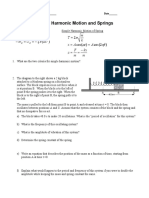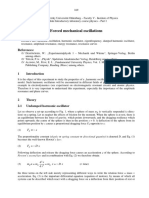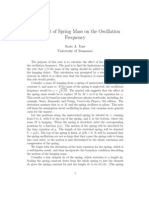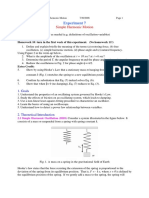0 ratings0% found this document useful (0 votes)
45 viewsOscillations: Objectives
This document discusses oscillatory systems and describes an experiment to study the oscillations of a mass suspended from a spring. It provides theoretical background on simple harmonic oscillators and how oscillations are affected by factors like friction. The experimental procedure involves using a sonic ranger and force probe to collect position and force data over time as a mass suspended from different springs oscillates. The goal is to measure oscillation frequencies and spring constants for different masses and springs, and compare the results to theoretical predictions.
Uploaded by
NanaHanunCopyright
© © All Rights Reserved
Available Formats
Download as PDF, TXT or read online on Scribd
0 ratings0% found this document useful (0 votes)
45 viewsOscillations: Objectives
This document discusses oscillatory systems and describes an experiment to study the oscillations of a mass suspended from a spring. It provides theoretical background on simple harmonic oscillators and how oscillations are affected by factors like friction. The experimental procedure involves using a sonic ranger and force probe to collect position and force data over time as a mass suspended from different springs oscillates. The goal is to measure oscillation frequencies and spring constants for different masses and springs, and compare the results to theoretical predictions.
Uploaded by
NanaHanunCopyright
© © All Rights Reserved
Available Formats
Download as PDF, TXT or read online on Scribd
You are on page 1/ 5
Oscillations
"Physics is experience, arranged in economical order."
E. Mach
OBJECTIVES
To study some simple oscillatory systems.
THEORY
Typical dictionary definitions of the verb "oscillate" are "to move or travel back and forth
between two points" and "to vary above and below a mean value". Physics uses the word in
essentially the same way, and recognizes a wide range of mechanical and electrical systems that
oscillate. One of the simplest possibilities is a mass connected to a spring in such a way that the
mass can move back and forth if pushed away from an equilibrium position. This system
contains the two essential elements of an oscillator: Something to move back and forth, and some
mechanism to provide a restoring force. Another mechanical example would be a solid bar,
clamped at one end. It will vibrate if struck, but here the moving mass and the spring are the
same material. A capacitor and an inductor provide an electrical realization of exactly the same
equation as the mass and spring.
In this exercise we will study the motion of a mass suspended from a springy material, as
shown schematically in Fig. 1. We assume that the mass can only move vertically, and take the
origin at the point where the spring is not stretched at all. The equation of motion, including both
the gravitational and spring forces, is
!
"
Fig. 1 Idealized mass and spring oscillator.
PHYS 111 Oscillations 2
!
!
"
!#
!
! $ !
%""#
&
(1)
When the mass is not moving it will be at an equilibrium position !
"
given by the solution of
!!"
#
" ! $% (2)
If the mass moving we expect it to oscillate around the equilibrium position, and if we knew the
form of #$!% we might be able to solve Eq. 1 to find a description of the motion.
Physics textbooks usually consider the case of a "simple harmonic oscillator". The simple
harmonic oscillator is constructed with an ideal massless spring, for which the force is a linear
function of the stretch
!!"" ! #" (3)
The constant of proportionality & is called the spring constant. This assumption is made mostly
because it is fairly easy to solve Eq. 1 for this force, although it is also possible to manufacture
springs which are approximately linear. The equation of motion is then
!
!
"
!#
!
! $ !
%
&
" (4)
The solution for the stretch as a function of time is
! ! "!"#$!# ""% " !
$
(5)
where A and ! are constants determined by the initial conditions, !
"
is the equilibrium position,
and " is the angular frequency of oscillation, given by
! ! ! ! " (6)
A derivation of the result is in your text, or you can show that it is correct by substituting ! from
Eq. 5 into Eq. 4.
When #$!% is not so simple it may or may not be possible to write down a general
analytic solution to Eq. 1. We can still make progress by considering small-amplitude
PHYS 111 Oscillations 3
oscillations, for which ! remains close to !
"
. Expanding #$!% in a Taylor series around !
"
gives
the expression
!!"" ! !!"
#
" " $
#
!" ! "
#
" (7)
where we have neglected all terms of the infinite series beyond the first two. The constant &
"
is
given by
!
"
!
#$!%"
#%
%
"
(8)
Substituting this approximation for F(x) into Eq. 1, and simplifying with relation 2, we get the
approximate equation of motion
!
!
"
!#
!
!
$
%
"
%
&
!
$
%
&
" (9)
Since we kept only the linear variation of the force, the equation of motion has exactly the same
form as for simple harmonic motion, and will have the same solution. We therefore expect that
small oscillations about the equilibrium position will occur with frequency
! ! !
"
! # (10)
when the effective spring constant &
"
is found from the slope of the #$!% curve at !
"
according to
Eq. 8.
One final complication is that the system may have friction of some sort. This could be
due to air resistance or to some internal process in the spring material. Whatever the cause, the
conversion of mechanical energy to some other form will cause the oscillations to gradually
decrease in amplitude. For many circumstances, the decrease is exponential, leading to a solution
of the form
! ! "#
!"$
!"#$#$ " $% " !
#
(11)
where ! is a constant determined by the nature of the energy loss. There will also be a decrease in
the oscillation frequency, but it is usually small if the damping is weak enough that oscillation
persists for at least several cycles.
PHYS 111 Oscillations 4
EXPERIMENTAL PROCEDURE
1. Data acquisition and analysis
The overall experimental setup is shown in Fig. 2. A small bucket to hold various weights
hangs from a spring. The spring, in turn, is held by a force probe on a support arm which is
clamped to a lab table. Stretch is measured by a sonic ranger which sits on the floor directly
under the weight bucket, pointing up. A box with a wire mesh window protects the ranger from
falling weights.
Data acquisition is accomplished with LoggerPro software. Start the program by double-
clicking an icon labeled Oscillators.cmbl, or load the file after the program is running. This will
give you a good starting point for this exercise.
To test the process, you can suspend the bucket, loaded with a few hundred grams, from
the helical metal spring. If you displace the bucket vertically and then start data acquisition you
should get a plot of stretch vs time showing decreasing oscillations, and a plot of force vs
position. The plots may become irregular if the sonic ranger is confused by other obstacles, if it
is not under the bucket, or if the bucket swings sideways too much.
Before taking data, calibrate the force probe on the 10N range. It is also convenient to set
the zero of the position plot at the equilibrium position for the mass and spring. Go to Experiment
> Zero... or click on the zero icon on the tool bar, unselect the force probe, and click OK. The
sonic ranger will run very briefly, and the menu will close. The distance plotted is now relative
to the equilibrium position of the bucket.
Once you have a clear and properly-zeroed display of the oscillation, you can do a
quantitative comparison with Eq. 11. Using the Damped sine function
spring
bucket with weights
sonic ranger
under shield
support
bar
lab table
force probe
Fig. 2 Physical arrangement for oscillation measurements.
PHYS 111 Oscillations 5
A*exp(-B*t)*sin(C*t+D)+E (12)
in the automatic curve fit, click Try Fit as usual to let the program optimize the parameters shown.
If the results are unreasonable, edit the parameters to give a more reasonable starting point, click
Automatic, and Try Fit again. When the fit is satisfactory, record the oscillation frequency for later
analysis.
You will also want to measure the slope of the force vs position curve to get an effective
spring constant to compare with your oscillation frequencies. To do this, simply determine the
slope of the force-position graph for each equilibrium position you use.
2. Measurement program
Two springs, with different characteristics, are available. One is a wire helix, for which
the force is supposed to be approximately linear. The other is a large rubber band. You should
determine the oscillation frequencies and effective spring constants of each spring for several
weights, corresponding to a range of !
"
. You can then compare the prediction of Eq. 10 that
!
"
! #!
!
(13)
with the values of #
"
that you measure directly from the force vs position curve. If you choose to
use rather small masses the agreement might be improved by accounting for the mass of the
spring, a portion of which is in motion. The usual claim is that you add 1/3 of the mass of the
spring to the overall mass in Eq. 13.
For the metal spring the maximum stretched length to avoid damage is about 80 cm,
while the rubber band will only stretch about 75 cm before breaking. Without exceeding those
limits, determine the oscillation frequency and effective spring constant for several different
masses for both types of spring.
Your data will probably show that #
"
is nearly constant for the metal helix, but varies
significantly with !
"
for the rubber band. Obtain a force vs position curve for the full range of
positions from unstretched to maximum stretch for each spring, and use the curves to explain the
different behaviors of #
"
.
For the rubber band you will probably also note that the force vs position curve is
different for extension and contraction, a phenomenon called hysteresis. Since the mechanical
work done is different for the two directions of motion, mechanical energy will be converted to
heat over an oscillation cycle, accounting for the strong damping you observed. The metal helix
has little or no hysteresis and correspondingly small damping.
You might also like
- Phys 1401 Experiment 10 Simple Harmonic Motion COmpleted100% (1)Phys 1401 Experiment 10 Simple Harmonic Motion COmpleted15 pages
- TU10 - OnlineMassSpringLab - Complete PDFNo ratings yetTU10 - OnlineMassSpringLab - Complete PDF6 pages
- Lab11 - S23 - Instruction - SHM of A Spring-Mass SystemNo ratings yetLab11 - S23 - Instruction - SHM of A Spring-Mass System6 pages
- Notes On Mechanical Vibrations: 1 Masses and Springs-The Linear OscillatorNo ratings yetNotes On Mechanical Vibrations: 1 Masses and Springs-The Linear Oscillator10 pages
- Jasper Shin Physics IA Makeup - Spring OscillationxNo ratings yetJasper Shin Physics IA Makeup - Spring Oscillationx11 pages
- Lab 11 - Free, Damped, and Forced OscillationsNo ratings yetLab 11 - Free, Damped, and Forced Oscillations14 pages
- MEN-351-criticl Speed-Manuscript 20181225No ratings yetMEN-351-criticl Speed-Manuscript 201812258 pages
- PHY_2020_Experiment_1__Coupled_PendulumNo ratings yetPHY_2020_Experiment_1__Coupled_Pendulum21 pages
- PFE LESSON 5_ ELASTICITY AND OSCILLATION.docxNo ratings yetPFE LESSON 5_ ELASTICITY AND OSCILLATION.docx14 pages
- The Heavy Spring at Work: Amelia Carolina SparavignaNo ratings yetThe Heavy Spring at Work: Amelia Carolina Sparavigna8 pages
- Lab # 5 and 6: Simple Harmonic OscillatorNo ratings yetLab # 5 and 6: Simple Harmonic Oscillator6 pages
- 2021 Maual for simple Harmonic Motion(최종)No ratings yet2021 Maual for simple Harmonic Motion(최종)10 pages
- Physics 2nd Assignment Deney Harmonic MothionNo ratings yetPhysics 2nd Assignment Deney Harmonic Mothion4 pages
- Title: Natural Frequency of Spring Mass System Without DampingNo ratings yetTitle: Natural Frequency of Spring Mass System Without Damping15 pages
- Mathematical Solution Unifying the Four Fundamental Forces in NatureFrom EverandMathematical Solution Unifying the Four Fundamental Forces in NatureNo ratings yet
- Charge Radiation Derived from the Universal Electrodynamic Force - Proof of the Cherenkov EffectFrom EverandCharge Radiation Derived from the Universal Electrodynamic Force - Proof of the Cherenkov EffectNo ratings yet
- Eaton 93e Ups 40kva 60kva Generation 3 ManualNo ratings yetEaton 93e Ups 40kva 60kva Generation 3 Manual120 pages
- Energy Security and Management of Bangladesh (Petroleum Prospect)No ratings yetEnergy Security and Management of Bangladesh (Petroleum Prospect)4 pages
- Comparative Study Between Mechanical and Hydraulic BrakingNo ratings yetComparative Study Between Mechanical and Hydraulic Braking19 pages
- EL CICLO DE LA VIDA DE LOS RODAMIENTOS SKF - Ayude A Sus Rodamientos A Alcanzar Su Vidaútil MáximaNo ratings yetEL CICLO DE LA VIDA DE LOS RODAMIENTOS SKF - Ayude A Sus Rodamientos A Alcanzar Su Vidaútil Máxima22 pages
- Oscillations and Waves: The Vibration of An Object0% (1)Oscillations and Waves: The Vibration of An Object16 pages
- HL-01A Hydrogen Liquefaction - A Review of The Fundamental Physic, Engineering Practice and FutureNo ratings yetHL-01A Hydrogen Liquefaction - A Review of The Fundamental Physic, Engineering Practice and Future42 pages
- As GROVE - Physics and Technology of Semiconductor DevicesNo ratings yetAs GROVE - Physics and Technology of Semiconductor Devices198 pages
- The Shell Model As Unified View of Nuclear StructureNo ratings yetThe Shell Model As Unified View of Nuclear Structure64 pages
- An Overview of National Climate Change Strategies and Priorities in Papua New GuineaNo ratings yetAn Overview of National Climate Change Strategies and Priorities in Papua New Guinea10 pages
- Getting Started Guide 475 Field Communicator en 38448 PDFNo ratings yetGetting Started Guide 475 Field Communicator en 38448 PDF14 pages
- EV2460-PV Battery Pack Specification 15101627 AmnntapNo ratings yetEV2460-PV Battery Pack Specification 15101627 Amnntap8 pages
- Phys 1401 Experiment 10 Simple Harmonic Motion COmpletedPhys 1401 Experiment 10 Simple Harmonic Motion COmpleted
- Lab11 - S23 - Instruction - SHM of A Spring-Mass SystemLab11 - S23 - Instruction - SHM of A Spring-Mass System
- Notes On Mechanical Vibrations: 1 Masses and Springs-The Linear OscillatorNotes On Mechanical Vibrations: 1 Masses and Springs-The Linear Oscillator
- Jasper Shin Physics IA Makeup - Spring OscillationxJasper Shin Physics IA Makeup - Spring Oscillationx
- The Heavy Spring at Work: Amelia Carolina SparavignaThe Heavy Spring at Work: Amelia Carolina Sparavigna
- Title: Natural Frequency of Spring Mass System Without DampingTitle: Natural Frequency of Spring Mass System Without Damping
- Mathematical Solution Unifying the Four Fundamental Forces in NatureFrom EverandMathematical Solution Unifying the Four Fundamental Forces in Nature
- Charge Radiation Derived from the Universal Electrodynamic Force - Proof of the Cherenkov EffectFrom EverandCharge Radiation Derived from the Universal Electrodynamic Force - Proof of the Cherenkov Effect
- Energy Security and Management of Bangladesh (Petroleum Prospect)Energy Security and Management of Bangladesh (Petroleum Prospect)
- Comparative Study Between Mechanical and Hydraulic BrakingComparative Study Between Mechanical and Hydraulic Braking
- EL CICLO DE LA VIDA DE LOS RODAMIENTOS SKF - Ayude A Sus Rodamientos A Alcanzar Su Vidaútil MáximaEL CICLO DE LA VIDA DE LOS RODAMIENTOS SKF - Ayude A Sus Rodamientos A Alcanzar Su Vidaútil Máxima
- Oscillations and Waves: The Vibration of An ObjectOscillations and Waves: The Vibration of An Object
- HL-01A Hydrogen Liquefaction - A Review of The Fundamental Physic, Engineering Practice and FutureHL-01A Hydrogen Liquefaction - A Review of The Fundamental Physic, Engineering Practice and Future
- As GROVE - Physics and Technology of Semiconductor DevicesAs GROVE - Physics and Technology of Semiconductor Devices
- The Shell Model As Unified View of Nuclear StructureThe Shell Model As Unified View of Nuclear Structure
- An Overview of National Climate Change Strategies and Priorities in Papua New GuineaAn Overview of National Climate Change Strategies and Priorities in Papua New Guinea
- Getting Started Guide 475 Field Communicator en 38448 PDFGetting Started Guide 475 Field Communicator en 38448 PDF
- EV2460-PV Battery Pack Specification 15101627 AmnntapEV2460-PV Battery Pack Specification 15101627 Amnntap

























































































